Decentralizing Entrepreneurship: Antyodaya by words and spirit
Total Views |
-Kapil Sahasrabuddhe
Sunil Valvi and his family are from Talavipada village, Nandurbar. Sunil and his wife are a young couple in their 20’s. Few years back, they started a small mobile rice mill. Sunil took loan for the same. In a mere years’ time, he repaid the entire loan. His small rice mill was a kind of gift for 100 women in Talavipada. Rice mill in the backyard have reduced their efforts to mill the rice manually. People used to mill rice in hullars where rice grain loss was more. Mill helped to reduce the same. It also saved their time and money to go to other villages to mill the rice. Apart from these non-monetary benefits, families could sell rice rather than selling paddy which gets half the price of rice. Slowly he improved his enterprise, added a flour mill. Today he earns more than a lakh per year. As a gratitude towards neighbors and support they received in their struggle, Sunil’s family has decided to provide small financial support to neighbors without taking any interest. This is a unique way to return back to society.
When I met Sunil last year, he and his family were in full spirit of improving their enterprise. Their decision to support people monetarily mesmerizes me more than their enterprise. I will not be able to forget the joy on their face when they were telling me their story. I tried to correlate this with other pictures I saw while traveling in other parts of Maharashtra.
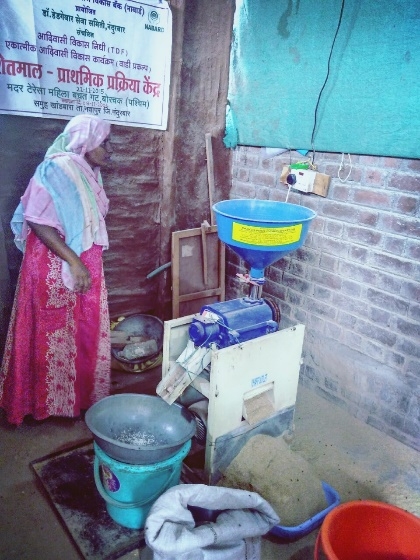
Migrating to survive
Two years back, I travelled in different parts of Marathwada especially in Aurangabad, Beed and nearby districts. During travel I came across three large sugar mills and a dairy. All were closed. On the other hand, farmlands were full of millets like Jowar, Bajara etc. Similarly, in the last two years, after Diwali, I travelled in Javhar, Palghar, Peth, Suragana areas of Sahyadri Mountains and Dhadgaon Akkalkuwa areas in Satpuda. People were busy in harvesting as well as planning for migration to cities. Most of them will go to some construction site or other petty work or big cash crop farmers for wage work. This is the situation of one of the prosperous states, Maharashtra. Most of the rainfed areas and tribal areas of Maharashtra, which is more than 60% of the area, face employment issues and tend to migrate to cities after monsoon.
Maharashtra has 5 major areas. Kokan, Western Maharashtra, Marathwada, Khandesh and Vidarbha. All these areas had a prosperous history and unique systems. Paithan in Marathwada was actually the capital of Maharashtra for many years. All these areas have some unique production and livelihood systems. Paithan was known to have tie ups with Roman Empire and ships full of gold used to come to Maharashtra port. Just 400 years back, India’s contribution was around 33% of the total GDP of world. Where are we today?. Our current GDP share to world GDP is below 10% for last so many years. We have one of the highest poor population in the world. In all indicators, we are down from very smaller countries in the world. What happened to us? What went wrong?
Reasons: Something deeper than usual
One of the key reasons is we lost our own thinking and philosophy for development. We started borrowing concepts and philosophy to develop ourselves. Engine of our development train lost its track. We all know coaches just follow the engine. They do not have brains. One of the key conceptual mistakes was calling India as Primarily an agricultural nation which India never was. No doubt agriculture was a key area and we developed it exponentially. But along with agriculture, we equally promoted industry, processing, trade.
Just think about this, if we were only primarily an agricultural country, how could there be export of clothes and Swords, other metal utensils to other countries? How was India the only country to export color clothes? How a so called ‘undeveloped country’ has all needed industries with well-developed equipment suited for its raw produce in every village?
But we never tried to answer these questions. We just followed western world after independence. We copied their model and that copy was also miserable. As, we followed Industrial model, cities became manufacturers and all fringe areas became providers and consumers. Just take examples of edible oils. Rural areas produce oil seeds, sell them at throw away prices to the oil industry and purchase oil from shops with high rates. Wealth is going out. We also copied models which worked in one area of our country to other areas where they didn’t. Let’s take the example of Sugar Mills. They worked well in Western Maharashtra and gave financial stability to farmers. But the same didn’t work in other areas and became a liability. One of the key factors we missed is natural capital available in the area where certain things worked. So Sahyadri water was not considered when one copied the sugar model in Marathwada or part of Khandesh. One can give examples of Operation flood for producing milk, operation blue for fish etc.
Are we learning from these experiences? Don’t think so! In the last decade, skill development was a buzzword in India. You can see skill improvement programmes all over the country. Some of them were quite necessary in a changed situation. But most of them were focused on transportation of quality human resources outside their villages. Very few, that also in some nook and corner, were emphasizing on developing capacities in villages. So, we don’t seem to be learning from what happened in the last 70 years of the growth model and still continuing the same path. But what are options? Where are those? Who is working on them? Are they upscalable? Will they provide enough jobs? Are people willing to do those? …….
Appropriate solutions, catalyze change
In Nandurbar district of Maharashtra, silent change is happening on village enterprise development by joint efforts of community, technical organization and NGOs. Rice is a staple crop in Navapur tehsil of Nandurbar. It is also an important crop for income generation. Unfortunately, whole tehsil does not have good processing facilities of rice. Local village level units were inefficient and large units were average 40-50 km from any village in Navapur except few boundary villages. So, people are suffering both ways, locally they lose rice quantity and if one goes to mills, they do not get good price due to quantity, time and many other factors. Dr. Hedgewar Seva Samiti – Krushi vigyan Kendra studied this situation. After careful study, it was realized that a small intervention can help to change the situation. They introduced a Mobile Rice Mill.
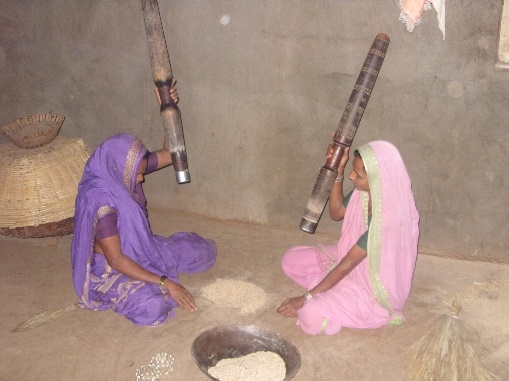
It is a simple, home based unit which can provide milling service to minimum 100 families in a village. It took 3-4 to years to stabilize its operations. But once it was stabilized, it was accepted by the community in no time. Today 23 such small rice mills are operational in the area. This improved milling system helped to improve rice quality, reduce waste and time consumed in milling, improved selling value and increased income of families. A study by an independent consultant in 2019 showed that the average income of rice mill operator is Rs.10000-12000 per month. About 3000 families were directly benefited from these efforts in these villages and could increase their income. About 3000 women were benefited by reducing milling time and drudgery associated with the same.
KVK has worked on different such models like nursey of vegetables, dal mills, small poultry, whaet processing, amchur processing etc. More than 50 enterprises are successfully running in Nandurbar considering local needs. A blend of agriculture development and associated enterprise is changing local scenario. Many of these units are providing services to people and increasing the value of local agriculture produce.
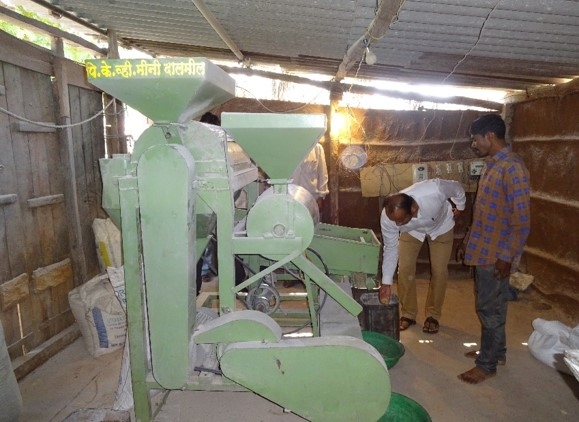
A well-studied and adapted small processing intervention can impact at a scale. It helped to set up decentralized support system, increase income, decrease drudgery of women and more importantly give confidence to set up similar systems in the area.
It is possible everywhere
One can see similar efforts in forest produce in another area of Nandurbar district. Akkalkuwa is the last tehsil of Maharashtra on northern borders with good forest cover. Local community is engaged in collection and sale of forest produce like Mahua, Custard Apple, amchur etc. It is an important income generation activity. But most of them are selling it in distress as all collect and sell at same time due to its production cycle. Due to such compulsion, they end up getting very little income from these produces.
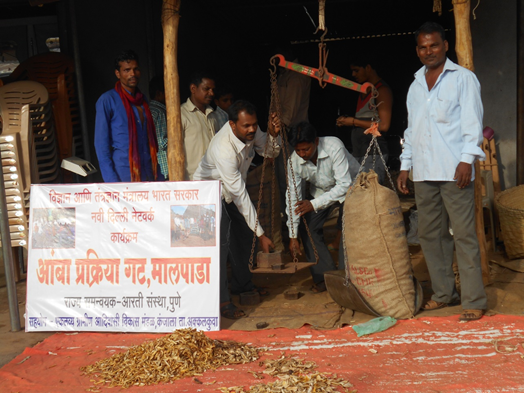
A local NGO Ekalavya Gramin Adivasi Viaks Mandal, Kanjala, local SHGs and community members decided to break this vicious cycle. They purchased Mahua in the village and stored it using a scientifically tested bamboo-based storage system. This stored mahua was sold in the market after monsoon to traders and other villagers. They could get double the price. Similarly, they segregated and sold Custard apples in the major market of Surat with good profit. Intervention in local amchur trade was much beneficial and gave good returns.
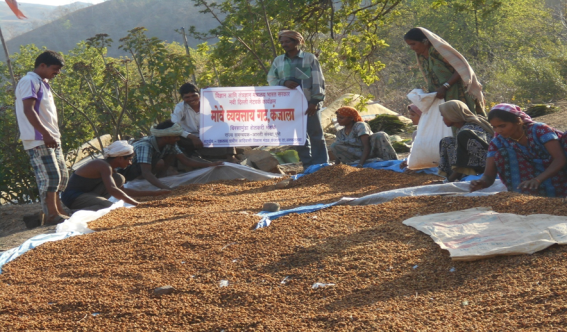
Decentralization empowers community
These examples are shared just to highlight the potential of such efforts. The basic principle is to improve the value of local agri/forest produce and improve returns by using modern, scientific technology. Decentralization is another important aspect. Both of these factors are important in a large country like India. It will reduce investment, make investment affordable and more importantly it can be handled by the so-called illiterate community in remote areas of the country. Overall efforts in Nandurbar shows that a village can start 8-10 new enterprises which can provide services to village as well as increase the value of agri/forest produce available with villagers. Average investment for all these enterprises per village is Rs.20 lakhs. This can directly provide employment to minimum 10 families per village and improve income by 20-30% for 100 families. There are 6 lakh villages in India. If we exclude 1 lakh villages due to remoteness and /or excess urban pressure, we still have 5 lakh villages which have potential to start such 8-10 enterprises each. This will directly provide employment to 50 lakh families and improve income of 5 crore families from rural India. This is enormous potential which requires attention!
Antyodaya path is difficult but…
This path is not that easy. We need to invest into studies, research of suitable enterprises in each village, need documentation of natural resources and its potential at village level. We need to identify appropriate technology, technology providers and useful machinery for a diverse country like India. On other hand we need to mobilise the community, provide confidence, create a conducive system for enterprise development in villages and provide basic infrastructure. We also need to create innovative financial instruments which can produce continuous loops, encourage community to repay. This is not new to us as we all do this for urban startups and multinationals in our country. Now that our political leadership has decided to double farmers income, we just need to extend all this to our villages.
Decentralized enterprises provide service and improve the value of produce. It caters to the needs of the last person and improves the life of these people. Pandit Deen Dayal Upadhyay advocates such decentralized enterprise system in Ekatma Manav Darshan. Decentralization is the path of Antyodaya. Are we ready to walk?
(English language input from Pradnya Joglekar)

